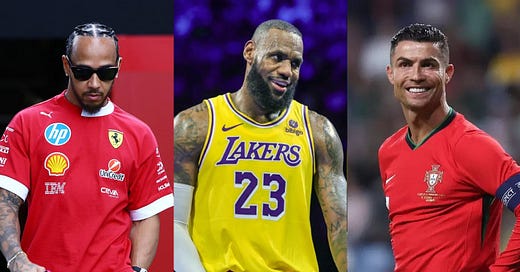3 GOAT's at 40: How Ronaldo, LeBron and Hamilton Have Defied Athletic Timelines
From physical evolution to mindset mastery, three sporting icons are proving that greatness doesn’t fade—it adapts.
In sport, turning 30 was once the point where pundits started sharpening retirement speeches. But Cristiano Ronaldo, LeBron James, and Lewis Hamilton didn’t just stretch the narrative, they shattered it.
Now at 40, all three remain not only present in their respective arenas but still influencing, still competing, still mattering. They’ve redefined what it means to be elite, not just in performance, but in presence.
Their stories are different. One a footballer (soccer) who went from Madeira to Manchester and beyond. One a high-school prodigy-turned-basketball royalty. One a British driver who fought a tough road en route to Formula 1 history. But today, they all share something special: the rejection of athletic expiry dates.
The notion that 30 signals the decline of an athlete is rooted in outdated conditioning. Footballers would fade by their early 30s, basketball players would lose their explosiveness, and racing drivers were assumed to lose their nerve.
But science, money, and mindset have changed the game.
LeBron spends a lot of money on maintaining his body, including cryotherapy, hyperbaric chambers, and personal chefs. Ronaldo’s training and recovery regime is obsessive, often compared to military-grade dedication. Hamilton, meanwhile, has spoken openly about his plant-based diet, meditation, and focus on mental health as performance tools. These men are biohacking their bodies in real time.
What makes this trio different isn’t just physical maintenance, it’s evolution.
Ronaldo, once a winger who terrorised defenders with explosive dribbles, has transformed into a penalty-box predator. His aerial dominance, positioning, and one-touch finishing now define his game, not his sprint speed. He’s scoring different goals, but still scoring.
LeBron is no longer the high-flying dunk machine of his youth. He’s a floor general now, dictating pace, dissecting defences, pulling strings. His game IQ has become his superpower.
Hamilton’s driving has also evolved. Early on, he was known for fearless overtakes and raw aggression. In recent years, he’s focused more on race strategy and consistency. The seven-time world champion is more cerebral behind the wheel now, balancing risk and precision in a way younger drivers are still learning.
Their greatness hasn’t stayed still; it’s shifted shape. This is due to their incredible ability as athletes to adapt, and why all three are in the GOAT conversations. Their sporting brains are probably more impressive than their physical attributes and why they’ve shone brightly over their competitors for so long.
Follow me for more sports and life updates: Instagram
Physical decline may be measurable, but mental sharpness and hunger are harder to quantify. That’s where the real separation lies.
To compete into your 40s at the elite level means waking up with motivation when you’ve already won everything. It means dealing with younger, hungrier challengers. It means not letting the voice in your head, saying “You’ve done enough”, get louder than the one that still wants more.
Ronaldo’s obsession with being the best is well documented. From post-match gym sessions to icy post-game interviews, his standards haven’t dropped. LeBron, despite four NBA titles and two decades of scrutiny, still talks about his “unfinished business.” And Hamilton seems to view success now as something bigger than just his seven world titles, it’s about changing culture.
They’re not just motivated by trophies, they’re fuelled by legacy.
These three aren’t just ageing differently. They’re ageing publicly, under the full glare of modern media. That matters. Because in doing so, they’ve become walking counter-arguments to ageism in sport.
And younger athletes are watching.
Kylian Mbappé has spoken admiringly about Ronaldo’s commitment and longevity. NBA stars like Jayson Tatum and Anthony Edwards grew up watching LeBron, and now share the court with him. George Russell and Lando Norris regularly cite Hamilton’s influence, not just on the track, but in how he carries himself off it.
They’re not just role models, they’re blueprints.
The truth is, they won’t keep playing forever. But their imprint won’t fade when they hang up their boots, sneakers, or helmets.
They’ve already won. Not just because of their titles, records, or trophies, but because they’ve altered the definition of what it means to age in sport.
They’ve shown that the 30s aren’t just a fade-out era. That greatness isn’t about one peak, but the ability to keep going at a high level.
And in doing so, Ronaldo, LeBron, and Hamilton haven’t just extended their careers. They’ve extended the vision of possibility for athletes and fans alike.
They’re by no means the only ones to compete at a high level into their 40s; Tiger won the Masters and Brady won the Super Bowl, both at 43, but to have three generational icons still competing simultaneously is incredible.
It sends a clear message to young athletes: take care of your body, your mind, and your circle, and the game doesn’t have to end as early as they thought.
Thank you for reading, David Skilling.
Follow me on LinkedIn | X | Instagram
If you hit the like button, you’ll be doing me a huge favour, and if your business needs sports writing, feel free to get in contact.
If you know someone who will enjoy this article, please share it with them.



